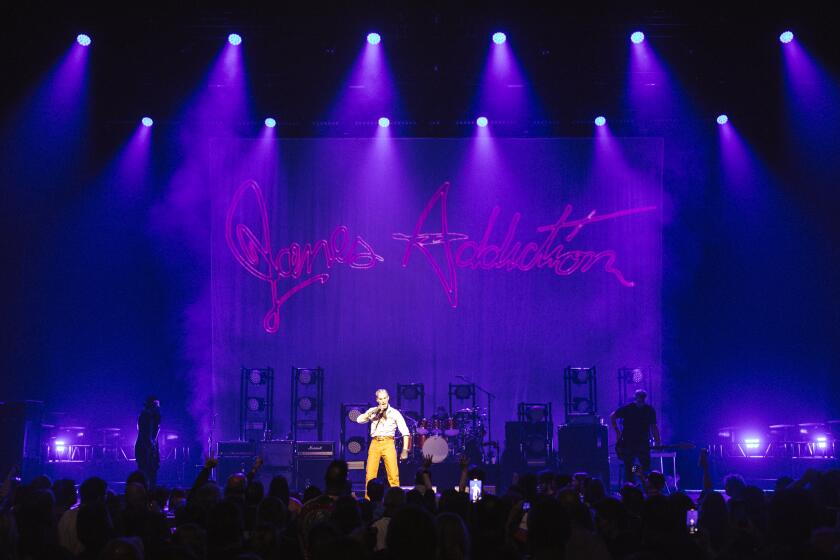JAZZ REVIEW : Land’s Stellar Sound Should Be Recorded
SAN DIEGO — Apparently, recording companies aren’t interested in one of jazz’s living legends. Los Angeles saxophonist Harold Land came up in the Max Roach-Clifford Brown Quintet of the mid-1950s and co-led a quintet from 1969 to 1971 with vibraphonist Bobby Hutcherson. At 63, he is in peak musical form, yet he hasn’t released a recording as a leader in eight years.
The labels seem more interested in “gimmicks” than in genuine jazz, Land lamented after his final set at the Horton Grand Hotel last weekend, where he appeared Friday and Saturday nights. But their lack of interest hasn’t dampened the charged, meditative aura of Land’s playing, which owes much to the late John Coltrane.
Besides his son, Land’s quartet for last weekend included San Diegans Chuck McPherson on drums and Bob Magnusson on bass, a group that came together just for these dates. Magnusson is always a solid choice, and McPherson is finding his own identity after dedicated years as a journeyman. His gutsy, polyrhythmic playing drove the up-tempo tunes with the intensity they demanded, yet he also knows how to lend soft support to a ballad.
An evening of jazz, especially with a pick-up group, is much like the lengthy Wimbledon tennis finals that took place over the weekend. Players test each other through the early sets before pulling out the stops for the finale.
Land, who grew up in San Diego and graduated from San Diego High School in 1946, opened his first set with “The Night Has a Thousand Eyes.” Land, Jr., contributed a technically awesome piano solo, his left and right hands delivering intricate, improvised lines in unison.
The set also included Land’s own composition “Rapture,” a slow, swinging mood piece marred by a scratchy sound system, the standard “Like Someone to Love,” Mel Torme’s “Born to be Blue” and Land’s “Step Right Up to the Bottom.” He closed both sets with this driving, up-tempo number.
Nattily dressed in a suit and tie, showing little emotion on his face, Land seemed, for a time, to be holding back, but by the end of the first set, the band hit a well-oiled groove. Land closed his eyes and went deep within himself to turn the frenzied ending of “Step Right Up” into an all-out jazz sermon.
The second set opened on a promising note with “Xocia’s Dance,” a medium tempo tune with a tropical beat written by Harold Land, Jr., the title cut from his father’s last solo album. Land, Sr., proved that he is a much younger man in spirit. His risky, expansive solo sounded like the work of an eager artist half his age.
Thelonious Monk’s “Rhythm-A-Ning” became a vehicle for the Lands’ Coltrane-Tyner mode, and Land, Sr., showed his softer side on “Willow Weep For Me,” although the uncooperative sound system again reared its ugly head. “On Green Dolphin Street” gave Land, Sr., room to stretch out on a gentle ballad before he closed the set with a blistering reprise of “Step Right Up To The Bottom,” spinning spirals of Coltrane-ish notes centered on gradually shifting tonal centers. He ended the song by repeating a mesmerizing, ascending four-note pattern over and over, and as it faded out, the ghost of the early sixties Coltrane-Tyner alliance seemed to float out into the midnight sky.
Although Land has not made a solo recording in years, he has worked off and on since the mid-1980s with the Timeless All-Stars, a stellar crew also including Hutcherson. Their newest album, recorded earlier this year, is due later this summer. But it will be a big disappointment if some label doesn’t snatch up Land soon for a solo project. He still has a lot of inspired jazz left in him.
More to Read
The biggest entertainment stories
Get our big stories about Hollywood, film, television, music, arts, culture and more right in your inbox as soon as they publish.
You may occasionally receive promotional content from the Los Angeles Times.










